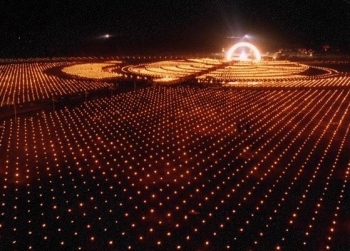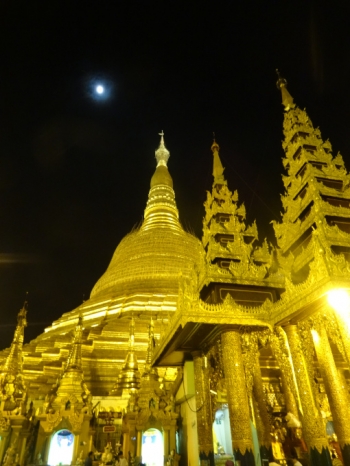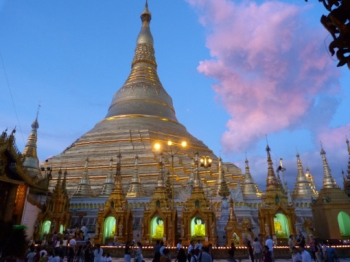The Southeast Asian countries Thailand, Cambodia, Laos, and Myanmar are known for their many colorful and enjoyable festivals. One of the most popular is Magha Puja or Sangha Day, an important Buddhist festival that extends across many cultures and beliefs. It is therefore unsurprising that this ancient celebration is the biggest and most eagerly awaited of all celebrations in Southeast Asia.
The festival takes place on the full moon day of the third lunar month, which falls around the last week of February or in early March. This year, the festival was celebrated generally on 4 March. This holy day commemorates an important event in the life of the Buddha when, at Veluvana Bamboo Grove near Rajagaha in present-day Bihar State, India, on an auspicious day some ten months after his enlightenment, four things occurred: (1) 1,250 men from different places assembled before him without prior appointment; (2) the Buddha ordained them as monks by saying “Ehibhikkhu” (“Come, monk!”); (3) they all became arhats; and (4) the Buddha gave them special instructions, called the Ovada Patimokkha (the Patimokkha Exhortation), laying down the fundamental rules of his teachings. These can be summarized in three points: refraining from harm, performing wholesome deeds, and purifying the mind. As these things happened on the day of the full moon, the full moon of Magha Puja day is also known as Sangha Day, or Assembly Day.
In Thailand, Magha Puja (Th: Makha Bucha) is one of the most prominent Buddhist festivals. It has increased in popularity over the last few years, whereas initially, only monks and royalty participated. Although it dates back to the 5th century BCE, it became a holy day in Thailand only during the 19th century, through the cultural reforms of King Rama IV (r. 1851–68). Nowadays, the celebration is enjoyed by millions of Thai Buddhists. On the auspicious day, they wake up early and give alms to monks, observe the Eight Precepts, practice renunciation, and meditate. In the evening, monastics give Dhamma talks to devotees and perform rituals such as the candle ceremony. For this, they walk around the temple clockwise three times holding a lighted candle, flowers, and incense.
One of the largest celebrations in Thailand is held at the temple Wat Phra Dhammakaya, which hosts an alms-round ceremony for over 1,000 monks at the Grand Meditation Square of the Great Dhammakaya Cetiya followed by guided meditation sessions and the offering of Sanghadana to the monastic community. In the afternoon, the temple presents the Royal Trophy and Awards to the winners of the Path of Progress Ethics Quiz Contest, one of UNESCO’s cultural programs for peace, which was established in 2002. The day concludes with an impressive performance called the “Magha Lantern Lighting Ceremony” as an offering of respect and reverence to the Buddha.
As Laos and Cambodia also follow Theravada Buddhism, like in Thailand, Magha Puja day is one of the major holidays in these countries. They both celebrate the occasion with a series of religious activities such as chanting, making offerings, grand parades, and candle-bearing. People accumulate merit by going to temples for special ceremonies such as the taking of the Eight Precepts, and participate in many other Buddhist activities.
In Myanmar, Magha Puja is called the “full moon of Tabaung or Tabodwe.” It begins at the new moon of the month of Tabodwe in the traditional Burmese calendar and continues until the full moon. The celebration takes place in pagodas and temples across the country with a nakyake shitsu ceremony of offerings to the 28 Buddhas (from Tanhankara to Shakyamuni), followed by a ten-day continuous recital of the Patthana (the last book of the Pali Abhidhamma)—a Buddhist scripture on the 24 causes of worldly phenomena. Traditionally, Buddhists visit temples on the full moon of Tabodwe to make offerings to the monks. It is also a day when devout Buddhists choose to fast or eat modestly, do good deeds, and avoid negative and inconsiderate actions.
The two largest festivals in Myanmar, the Kyaik Khauk Pagoda Festival and Shwedagon Pagoda Festival, are also celebrated during Tabodwe and commemorate major events in the pagodas’ history. The Kyaik Khauk Pagoda Festival begins on the eighth day of the waxing moon of Tabodwe, when Buddhist devotees observe the Eight Precepts. There are also a multitude of food stalls and merchandise stands, entertainments such as anyeint drama (a traditional Myanmar entertainment that combines dance with music), yoke performances (Myanmar puppetry), zat (a variety of dance, song, and short and long plays), and movies shown in the open air in the vicinity of the pagoda.
The Shwedagon Pagoda Festival was celebrated on 4 March this year, and is held to venerate the relics believed to be enshrined within the pagoda. Offerings of water, light, and flowers are made both to the pagoda itself and to the Buddha images in the grounds.
Festivals are a celebration which help break the monotony of life and bring peace, joy, and harmony to the people. In Southeast Asia, the Buddhist Magha Puja day is especially significant as it brings together people of many different backgrounds who share a common belief and interest. As the past reminds us, Southeast Asian countries have sometimes suffered political and economic conflicts, but the shared connection of Buddhism has enabled the people to survive. Although there is political instability in these neighboring countries, through religious cooperation they offer a great message of learning to live together in peace.
On Magha Puja, social hierarchies and class as well as personal distinctions are diminished, with people from all walks of life and diverse locations congregating to commemorate the Buddha and his great teachings. The day strongly symbolizes the ability of the people of different countries to come together, bound by similar beliefs. It is also an occasion for visitors to witness aspects of the Buddhist tradition and its practice in Southeast Asia.
For more information, see:
Magha Puja Day (Dhammakaya Temple)
Magha Puja Day 2015, March 4th, Offering Lights to Brighten Your Life (Dhamma Media Channel)
Cambodian Theravada Buddhists Celebrate MakhaBucha Day (Holidays Around The World)


















